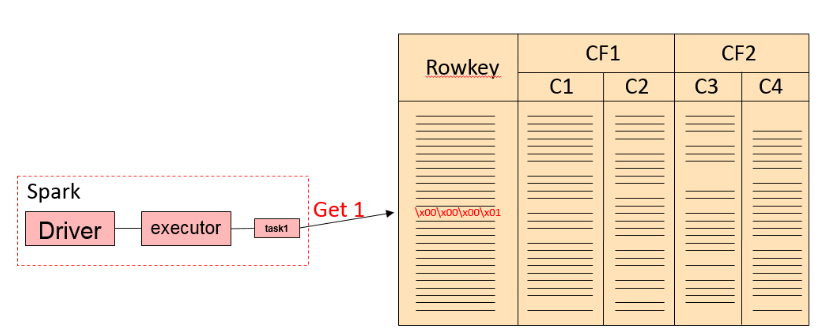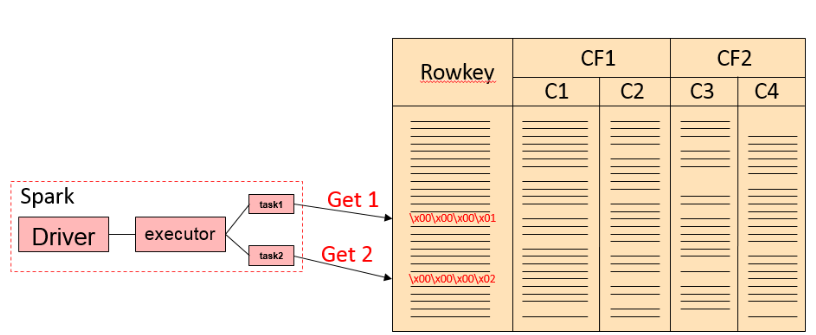Apache Spark 和 Apache HBase 是两个使用比较广泛的大数据组件。很多场景需要使用 Spark 分析/查询 HBase 中的数据,而目前 Spark 内置是支持很多数据源的,其中就包括了 HBase,但是内置的读取数据源还是使用了 TableInputFormat 来读取 HBase 中的数据。这个 TableInputFormat 有一些缺点:
- 一个 Task 里面只能启动一个 Scan 去 HBase 中读取数据;
- TableInputFormat 中不支持 BulkGet;
- 不能享受到 Spark SQL 内置的 catalyst 引擎的优化。
基于这些问题,来自 Hortonworks 的工程师们为我们带来了全新的 Apache Spark—Apache HBase Connector,下面简称 SHC。通过这个类库,我们可以直接使用 Spark SQL 将 DataFrame 中的数据写入到 HBase 中;而且我们也可以使用 Spark SQL 去查询 HBase 中的数据,在查询 HBase 的时候充分利用了 catalyst 引擎做了许多优化,比如分区修剪(partition pruning),列修剪(column pruning),谓词下推(predicate pushdown)和数据本地性(data locality)等等。因为有了这些优化,通过 Spark 查询 HBase 的速度有了很大的提升。
注意:SHC 同时还提供了将 DataFrame 中的数据直接写入到 HBase 中,但是整个代码并没有什么优化的地方,所以本文对这部分不进行介绍。感兴趣的读者可以直接到这里查看相关写数据到 HBase 的代码。
SHC 是如何实现查询优化的呢
SHC 主要使用下面的几种优化,使得 Spark 获取 HBase 的数据扫描范围得到减少,提高了数据读取的效率。
将使用 Rowkey 的查询转换成 get 查询
我们都知道,HBase 中使用 Get 查询的效率是非常高的,所以如果查询的过滤条件是针对 RowKey 进行的,那么我们可以将它转换成 Get 查询。为了说明这点,我们使用下面的例子进行说明。假设我们定义好的 HBase catalog 如下:
val catalog = s"""{ |"table":{"namespace":"default", "name":"iteblog", "tableCoder":"PrimitiveType"}, |"rowkey":"key", |"columns":{ |"col0":{"cf":"rowkey", "col":"id", "type":"int"}, |"col1":{"cf":"cf1", "col":"col1", "type":"boolean"}, |"col2":{"cf":"cf2", "col":"col2", "type":"double"}, |"col3":{"cf":"cf3", "col":"col3", "type":"float"}, |"col4":{"cf":"cf4", "col":"col4", "type":"int"}, |"col5":{"cf":"cf5", "col":"col5", "type":"bigint"}, |"col6":{"cf":"cf6", "col":"col6", "type":"smallint"}, |"col7":{"cf":"cf7", "col":"col7", "type":"string"}, |"col8":{"cf":"cf8", "col":"col8", "type":"tinyint"} |}|}""".stripMargin |
那么如果有类似下面的查询
val df = withCatalog(catalog)df.createOrReplaceTempView("iteblog_table")sqlContext.sql("select * from iteblog_table where id = 1")sqlContext.sql("select * from iteblog_table where id = 1 or id = 2")sqlContext.sql("select * from iteblog_table where id in (1, 2)") |
因为查询条件直接是针对 RowKey 进行的,所以这种情况直接可以转换成 Get 或者 BulkGet 请求的。第一个 SQL 查询过程类似于下面过程

后面两条 SQL 查询其实是等效的,在实现上会把 key in (x1, x2, x3..) 转换成 (key == x1) or (key == x2) or ... 的。整个查询流程如下:

如果我们的查询里面有 Rowkey 还有其他列的过滤,比如下面的例子
sqlContext.sql("select id, col6, col8 from iteblog_table where id = 1 and col7 = 'xxx'") |
那么上面的 SQL 翻译成 HBase 的下面查询
val filter = new SingleColumnValueFilter( Bytes.toBytes("cf7"), Bytes.toBytes("col7 ") CompareOp.EQUAL, Bytes.toBytes("xxx"))val g = new Get(Bytes.toBytes(1))g.addColumn(Bytes.toBytes("cf6"), Bytes.toBytes("col6"))g.addColumn(Bytes.toBytes("cf8"), Bytes.toBytes("col8"))g.setFilter(filter) |
如果有多个 and 条件,都是使用 SingleColumnValueFilter 进行过滤的,这个都好理解。如果我们有下面的查询
sqlContext.sql("select id, col6, col8 from iteblog_table where id = 1 or col7 = 'xxx'") |
那么在 shc 里面是怎么进行的呢?事实上,如果碰到非 RowKey 的过滤,那么这种查询是需要扫描 HBase 的全表的。上面的查询在 shc 里面就是将 HBase 里面的所有数据拿到,然后传输到 Spark ,再通过 Spark 里面进行过滤,可见 shc 在这种情况下效率是很低下的。
def or[T](left: HRF[T], right: HRF[T])(implicit ordering: Ordering[T]): HRF[T] = { val ranges = ScanRange.or(left.ranges, right.ranges) val typeFilter = TypedFilter.or(left.tf, right.tf) HRF(ranges, typeFilter, left.handled && right.handled)} |
同理,类似于下面的查询在 shc 里面其实都是全表扫描,并且将所有的数据返回到 Spark 层面上再进行一次过滤。
sqlContext.sql("select id, col6, col8 from iteblog_table where id = 1 or col7 <= 'xxx'")sqlContext.sql("select id, col6, col8 from iteblog_table where id = 1 or col7 >= 'xxx'")sqlContext.sql("select id, col6, col8 from iteblog_table where col7 = 'xxx'") |
很显然,这种方式查询效率并不高,一种可行的方案是将算子下推到 HBase 层面,在 HBase 层面通过 SingleColumnValueFilter 过滤一部分数据,然后再返回到 Spark,这样可以节省很多数据的传输。
组合 RowKey 的查询优化
shc 还支持组合 RowKey 的方式来建表,具体如下:
def cat = s"""{ |"table":{"namespace":"default", "name":"iteblog", "tableCoder":"PrimitiveType"}, |"rowkey":"key1:key2", |"columns":{ |"col00":{"cf":"rowkey", "col":"key1", "type":"string", "length":"6"}, |"col01":{"cf":"rowkey", "col":"key2", "type":"int"}, |"col1":{"cf":"cf1", "col":"col1", "type":"boolean"}, |"col2":{"cf":"cf2", "col":"col2", "type":"double"}, |"col3":{"cf":"cf3", "col":"col3", "type":"float"}, |"col4":{"cf":"cf4", "col":"col4", "type":"int"}, |"col5":{"cf":"cf5", "col":"col5", "type":"bigint"}, |"col6":{"cf":"cf6", "col":"col6", "type":"smallint"}, |"col7":{"cf":"cf7", "col":"col7", "type":"string"}, |"col8":{"cf":"cf8", "col":"col8", "type":"tinyint"} |} |}""".stripMargin |
上面的 col00 和 col01 两列组合成一个 rowkey,并且 col00 排在前面,col01 排在后面。比如 col00 ='row002',col01 = 2,那么组合的 rowkey 为 row002x00x00x00x02。那么在组合 Rowkey 的查询 shc 都有哪些优化呢?现在我们有如下查询
df.sqlContext.sql("select col00, col01, col1 from iteblog where col00 = 'row000' and col01 = 0").show() |
根据上面的信息,RowKey 其实是由 col00 和 col01 组合而成的,那么上面的查询其实可以将 col00 和 col01 进行拼接,然后组合成一个 RowKey,然后上面的查询其实可以转换成一个 Get 查询。但是在 shc 里面,上面的查询是转换成一个 scan 和一个 get 查询的。scan 的 startRow 为 row000,endRow 为 row000xffxffxffxff;get 的 rowkey 为 row000xffxffxffxff,然后再将所有符合条件的数据返回,最后再在 Spark 层面上做一次过滤,得到最后查询的结果。因为 shc 里面组合键查询的代码还没完善,所以当前实现应该不是最终的。
在 shc 里面下面两条 SQL 查询下沉到 HBase 的逻辑一致
df.sqlContext.sql("select col00, col01, col1 from iteblog where col00 = 'row000'").show()df.sqlContext.sql("select col00, col01, col1 from iteblog where col00 = 'row000' and col01 = 0").show() |
唯一区别是在 Spark 层面上的过滤。
scan 查询优化
如果我们的查询有 < 或 > 等查询过滤条件,比如下面的查询条件:
df.sqlContext.sql("select col00, col01, col1 from iteblog where col00 > 'row000' and col00 < 'row005'").show() |
这个在 shc 里面转换成 HBase 的过滤为一条 get 和 一个 scan,具体为 get 的 Rowkey 为 row0005xffxffxffxff;scan 的 startRow 为 row000,endRow 为 row005xffxffxffxff,然后将查询的结果返回到 spark 层面上进行过滤。
总体来说,shc 能在一定程度上对查询进行优化,避免了全表扫描。但是经过评测,shc 其实还有很多地方不够完善,算子下沉并没有下沉到 HBase 层面上进行。目前这个项目正在和 hbase 自带的 connectors 进行整合(https://github.com/apache/hbase-connectors),相关 issue 参见 Enhance the current spark-hbase connector。